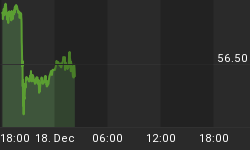For as quiet as it is, the current selloff in 10-year Treasury yields is the worst since March. The 35-basis point selloff still only puts 10-year yields as high as 1.73%, which is lower than they were at any time in 2011 except for one spike in September.
Real yields, however, have sold off only 17bps (current 10-year TIPS are at -0.55%), and moreover are still far from anything that looks like a reversal on the chart. Heck, the chart (Source: Bloomberg) looks almost linear. The TIPS market has never recovered from the fact that the Fed was for a time buying as much as the Treasury was issuing, so that for about 9 months there was no new supply in the market.

You would think that issuers would be lining up to issue at these real yields, but they are much more excited about issuing at these nominal yields. There just isn't enough supply of inflation-linked bonds at these levels, which is one of the reasons that TIPS yields will rise, but more-slowly than for nominal bonds, if this selloff continues.
The economic data is not conducive to a continued selloff, at least using the traditional rule of thumb that weak growth is good for bonds and strong growth is bad for bonds. European data today showed the Eurozone in contraction, as expected. Our domestic Retail Sales data was stronger-than-expected, but that was entirely accounted for by the upward revision to the prior month's data. The data recently have been on a modest upward trajectory, but there is nothing to be seen that smacks of a robust recovery. Meanwhile, some very large trading partners of ours are having serious growth issues. Yields are not 35bps higher because of "green shoots," that seems sure.
When you think about it, though, the traditional notion about growth being bad and recession good for bonds was largely formed in a period during which growth and inflation tended to move somewhat together because the central bank followed a conservative rule about money growth. There is no reason that it need necessarily be the case that slow growth is associated with low yields, any more than it is necessarily the case that slow growth be associated with low inflation. In the 1970s, yields were much higher than they are now despite similar economic languor. In fact, yields right now are even quite a bit lower than they were in the depths of the Great Depression (see Chart: source Federal Reserve, Technical Data, Bloomberg)!

So the rule of thumb really is that bonds respond to changes in growth expectations when inflation is low, and to changes in inflation expectations no matter what. This happens because while there's some de facto if not de jure ceiling for real rates - even if it is a little squishy - there is no ceiling or floor for inflation expectations.
Speaking of inflation, and inflation expectations, tomorrow the BLS releases the monthly CPI figures. Last month's print included a month-on-month core reading of +0.205%: the fourth consecutive month of at least +0.20%. The Wall Street consensus for tomorrow is +0.2% headline and +0.2% on the core, and annual figures of +1.6% on headline and +2.2% on core. Given the base effects, this implies that the true forecast for core inflation is actually in the range of 0.15%-0.22%, because below that range the month-on-month core figure would be +0.1% and above that range the year-on-year figure would be +2.3%. There is a much better chance of a round up to +2.3% than there is of a round down to +2.1%, because the latter would require a +0.12% print on core, a substantial miss that should be hard to come by given the underlying dynamics of housing, apparel, and some other components.
A round up, mind you, would really bum out a lot of people, including Fed governors. For the record, if we got a clean +0.3%, or pretty close to it, on core inflation it would move the year-on-year figure to a new (unrounded) post-crisis high. If we do get a round-up, I'd expect the equity market and the bond market to both perform quite poorly as investors marked down the probability of QE3. Commodities in that situation should get a boost, but that market doesn't always respond rationally. TIPS would probably also decline, but less than nominal bonds, and breakevens would widen.
I don't think that's a terribly long-shot outcome, for reasons I've discussed here over the last few weeks
















